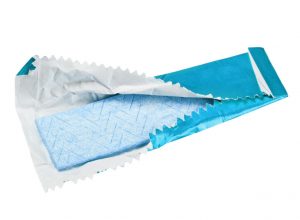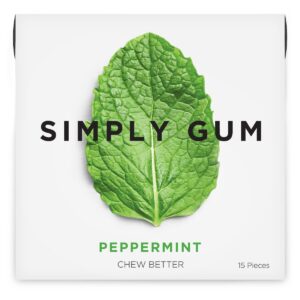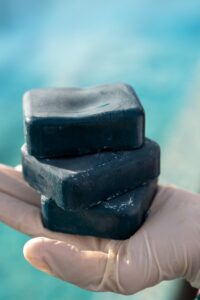
Chewing gum has been around a long time. Gum is historic – people chewed gum long before the Pilgrims.
In the Americas, the ancient Mayans chewed chicle, a substance shaved from the sapodilla tree; they used it to quench their thirst and fight hunger.
The Native Americans showed the European settlers how to chew the sap from spruce trees as far back as the 1600s.
Native Americans used pine needles to clean debris from their teeth as well as freshen their breath – natural dental floss LOL. A tuft of pine needles chewed for a little bit left the breath piney fresh, and it provided a small amount of vitamin C.
In the 1850s, the first commercial gum was taken from spruce trees where they boiled resin cut into strips and coated it in cornstarch to prevent it from sticking together.
In 1870, Weaton W. Kilbourn first mass-marketed chewing gum called Adams New York Chewing Gum to be a tobacco substitute gum. The US government provided troops with chewing gum during WWII to help make them more comfortable during wartime.

The first three flavors of gum were Peppermint, Spearmint, and Cinnamon.
Gum has enjoyed had a good reputation for:
- burning calories – you can burn 11 calories per hour when you chew gum;
- improving memory – chewing gum can boost blood flow to your brain, which can help improve your memory;
- avoiding sleepiness – if you feel tired, chewing gum can keep you alert;
- eliminating nausea.
So what happened? Gum isn’t the same today, and I don’t recommend any gum choices on the market today except for Simply Gum®. It’s made with pure cane sugar, and that beats artificial chemical sweeteners.
Most sugarless gums with or without aspartame have the sugar alcohols in them, especially xylitol or erythritol. As I wrote in my book, Splenda®: Is It Safe Or Not?, the sugar alcohols typically result in bloating, gas, and diarrhea.

If you MUST chew gum, I recommend a gum like Simply Gum.
Simply Gum is made with these ingredients:
- organic raw cane sugar
- natural chicle base (chicle, candelillia wax, citric acid)
- peppermint oil
- organic vegetable glycerin
- organic rice flour
It’s common for people to pick these ingredients apart, criticizing that it uses glycerin and wax, but stop and think about it … if you must chew gum, these ingredients beat aspartame, ace-K, or xylitol and erythritol.
Check out these ingredients in Orbit® gum, including 5 artificial sweeteners:
- sorbitol (sugar alcohol)
- gum base
- glycerol
- natural and artificial flavors
- less than 2% of:
- hydrogenated starch hydrolysate
- aspartame
- mannitol (sugar alcohol)
- acesulfame K
- soy lecithin
- xylitol (sugar alcohol)
- Bht (to maintain freshness)

Wax And Resin
Most gum has been made of three things:
- resin for chewiness,
- wax for softness,
- elastomers (silicon and rubber) to maintain elasticity.
Early chewing gums were made from tree-based resins and natural waxes, but these days, both ingredients are synthetically derived from petrochemicals.
Basically, gum today is essentially plastic and rubber.
Then came the chemical sweeteners to add to the plastic and rubber. Aspartame in gum is more common than you think, so if you want to avoid sugarless gum, make sure to read the label and the ingredients. Most gum packaging is not clearly labeled as “sugar-free” like it used to be a decade or so ago.
So heads up if you’re chewing gum to stay alert – read your labels!
_______________
If you want to learn more about healthy living and disease prevention, contact me at janethull.com. Remember that you are never alone when you are looking for good health!
Gain access to all of my online programs, ongoing support, monthly Q&A, and more by joining me on janethull.com. I look forward to supporting you on your journey to alternative health and wellness.
Join me on my radio show Healthy Alternatives every Thursday at 1:00 PM EST
healthyalternativesradiotv281.bravesites.com
_____________
Disclaimer: This article is for informational purposes only, and is educational in nature. The FDA may not have evaluated some of the statements. This article is not intended to diagnose, treat, cure, or prevent any disease. Please discuss with your own, qualified health care provider before adding supplements or making any changes to your dietary program.
Before taking vitamins, consult your doctor; pre-existing medical conditions or medications you are taking can affect how your body responds to multivitamins.
You have our permission to reprint this article if you attribute us with a live back-link to this article and the youtube links. http://www.janethull.com/
INFORMATION ON THIS WEB SITE IS PROVIDED FOR INFORMATIONAL AND EDUCATIONAL PURPOSES ONLY. THE INFORMATION IS A RESULT OF YEARS OF PRACTICE EXPERIENCE BY THE AUTHOR. THIS INFORMATION IS NOT INTENDED AS A SUBSTITUTE FOR THE ADVICE PROVIDED BY YOUR PHYSICIAN OR OTHER HEALTHCARE PROFESSIONAL OR ANY INFORMATION CONTAINED ON OR IN ANY PRODUCT LABEL OR PACKAGING. DO NOT USE THE INFORMATION ON THIS WEB SITE FOR DIAGNOSING OR TREATING A HEALTH PROBLEM OR DISEASE, OR PRESCRIBING MEDICATION OR OTHER TREATMENT. ALWAYS SPEAK WITH YOUR PHYSICIAN OR OTHER HEALTHCARE PROFESSIONAL BEFORE TAKING ANY MEDICATION OR NUTRITIONAL, HERBAL OR HOMEOPATHIC SUPPLEMENT, OR USING ANY TREATMENT FOR A HEALTH PROBLEM. IF YOU HAVE OR SUSPECT THAT YOU HAVE A MEDICAL PROBLEM, CONTACT YOUR HEALTH CARE PROVIDER IMMEDIATELY. DO NOT DISREGARD PROFESSIONAL MEDICAL ADVICE OR DELAY IN SEEKING PROFESSIONAL ADVICE BECAUSE OF SOMETHING YOU HAVE READ ON THIS WEB SITE. INFORMATION PROVIDED ON THIS WEB SITE AND THE USE OF ANY PRODUCTS OR SERVICES PURCHASED FROM OUR WEB SITE BY YOU DOES NOT CREATE A DOCTOR-PATIENT RELATIONSHIP BETWEEN YOU AND ANY OF THE PHYSICIANS AFFILIATED WITH OUR WEB SITE. INFORMATION AND STATEMENTS REGARDING DIETARY SUPPLEMENTS HAVE NOT BEEN EVALUATED BY THE FOOD AND DRUG ADMINISTRATION AND ARE NOT INTENDED TO DIAGNOSE, TREAT, CURE, OR PREVENT ANY DISEASE AND SERVE ONLY AS EDUCATIONAL